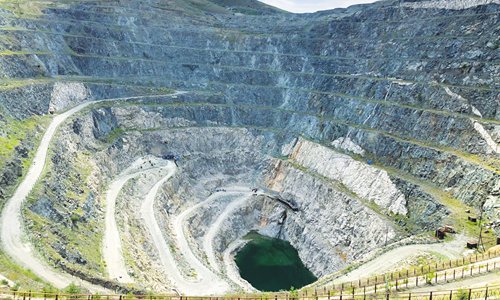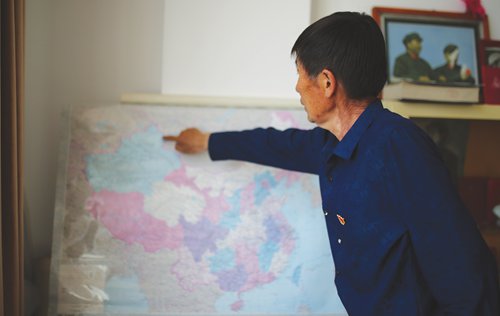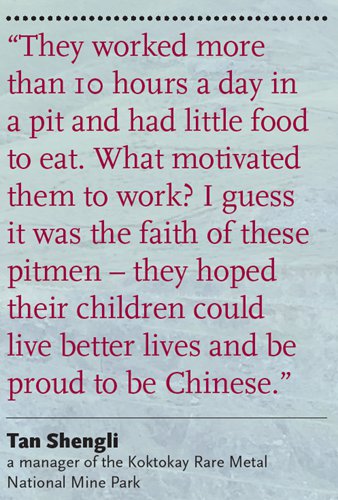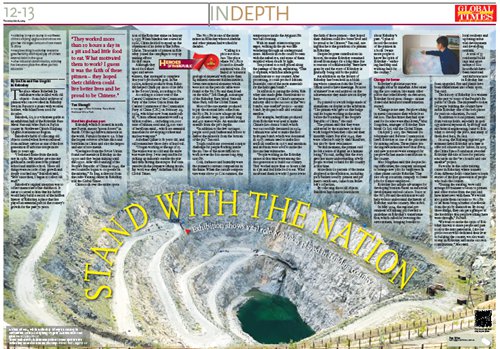HOME >> CHINA
Exhibition shows vital role Koktokay played in building country
By Liu Xin and Fan Lingzhi in Koktokay Source:Global Times Published: 2019/7/17 18:26:54
○ Koktokay in Fuyun county in Northwest China's Xinjiang Uyghur Autonomous Region has the largest amount of rare metals in China
○ People working in Koktokay overcame great hardship and helped pay off China's external debts in the 1960s
○ After industrial transformation, Koktokay has become a place that offers patriotic education

The place where Baketbek Jiasimuhan works is filled with old objects - from faded archives of pitmen who once worked in Koktokay town in Fuyun to a piano with wooden holders, which had been used for decades.
Baketbek, 60, is a volunteer guide at an exhibition hall of the Koktokay Rare Metal National Mine Park in Fuyun county in Northwest China's Xinjiang Uyghur Autonomous Region.
Baketbek's habit of collecting old objects started when he was released from military service as one of the first generation of airborne troops more than 30 years ago.
"I returned home from the military in 1982. My mother gave me my graduation certificates from primary school and middle school. These old things were records of my growth and deeply touched me," Baketbek said, "Ever since then, I began to collect old stuff."
Baketbek's original intention was to collect memories of his childhood. It never occurred to him that his hobby would help build a record of the hidden history of Koktokay, a place that has played an essential part in the country's growth for the past 70 years.
Hard but glorious past
Koktokay, which is located in northeast Fuyun, means "green forests" in Kazak. Of the 140 known minerals in the world, Fuyun is home to 92. It has the largest reserves of white mica and beryllium in China and also the largest amount of rare metals.
"Geologists from the Soviet Union found rare metals in Koktokay in the 1930s and they began mining until the 1950s. After the founding of the People's Republic of China in 1949, the two countries began to cooperate on the mining," Fu Jing, a director from the cadre training center in Koktokay, told the Global Times.
China took over the entire operation of the Koktokay mine on January 1, 1955. When bilateral ties soured in 1960, China decided to speed up the repayment of its debts to the Soviet Union. Thousands of pitmen in Koktokay joined the campaign to step up mining efforts for this cause.
Although they faced food shortages and severe winters, they managed to complete that year's production goal. In the 1960s, mineral products from Koktokay helped China pay most of its debt to the Soviet Union, according to Fu.
According to a letter sent to the Central Committee of the Communist Party of the Soviet Union from the Central Committee of the Communist Party of China (CPC) on February 29, 1964, which has now been made public, "China offered minerals worth 1.4 billion roubles…. including 100,000 tons of lithium sand and 34,000 tons of beryllium sand… which are essential materials for developing rockets and nuclear weapons."
Aidarhan Qilhar is 81 years old, and still remembers those days of hard toil.
"I began working at the age of 15. The winter was so cold and the snow was waist-deep. I was responsible for picking up minerals outside the pits and then driving the scraper. But compared with the pitmen working inside, my work was easy," Aidarhan told the Global Times.

The No.3 Pit is one of the many mines in Koktokay where Aidarhan and other pitmen had worked for decades.
"Calling it a pit is not accurate. The place where No.3 Pit is located is actually a mineral vein. It's hailed as 'a natural geological museum' with more than 84 mineral elements hidden inside it. Seven rare mineral elements which were not on the periodic table were found at the No.3 Pit and then listed on the table," Tan Shengli, a manager of the Koktokay Rare Metal National Mine Park, told the Global Times.
Most of the rare metals produced to pay the external debt came from the No.3 Pit. It is now a huge pit that is 236 meters deep, 520 meters long and 430 meters wide. An annular road extends from the pit's depths.
"In addition to the few carriages, people used pack baskets and horses to deliver the minerals from the bottom of the pit," Tan said.
Tough conditions presented a major challenge for people working inside the pit. One of the most difficult to work in was the 800-meter-long Ayiguozi Pit.
Cold, darkness and humidity were the pitmen's constant companions in the mine. When the outside temperature went above 30 C in summer, the temperature inside the Ayiguozi Pit was still freezing.
With its many crisscrossing passages, walking in the pit was like wandering through an underground maze. Minerals in rocks could be seen with the naked eye, and some of them twinkled when struck by light.
Tan pointed to a rock placed along the passage of the pit, explaining, "This is triphane, which has made great contributions to our country. After processing, it could produce lithium deuteride, one of the main materials for the hydrogen bomb."
In addition to paying the debts, Koktokay also made great contributions to the development of China's aerospace industry and to the success of the "two bombs, one satellite" project - atomic bomb, hydrogen bomb and artificial satellite.
For example, beryllium produced from Koktokay was used to make China's first atomic bomb, which was successfully detonated in 1964. Lithium was used to make the first hydrogen bomb, which was detonated in 1967, cesium used to make first artificial satellite in 1967; and tantalum and niobium were used to make the first nuclear submarine.
"People working in the Koktokay mines at that time were among the first generation to build our country. They worked more than 10 hours a day in a pit and had little food to eat. What motivated them to work? I guess it was the faith of these pitmen - they hoped their children could live better lives and be proud to be Chinese," Tan said, noting that he is the grandson of a pitman in Koktokay.
Despite its great contributions in history, the name Koktokay remained absent from maps for a long time due to reasons of confidentiality. Years have gone by and the story of Koktokay is gradually being told to the public.
An exhibition on the history of Koktokay has been held in a building where scientists from the Soviet Union used to have meetings. Pictures of miners' lives and archives on the achievements they made are on display here.
Fu pointed to a work badge made of aluminum on display at the exhibition. "The pitman who gave us this badge said he began working in the mine before the founding of the People's Republic of China," she said.
The pitmen said that they were addressed by the numbers on their work badges when they collected their monthly salary. But after 1949, they were called not only by their numbers, but also by their own names.
"At that moment, the pitman said he felt a sense of dignity as a human being," Fu said, noting that the story gave her more understanding of why people worked so hard for the country at that time.
More than 60 percent of the items displayed at the exhibition, including pack baskets used by pitmen and pitmen's certificates, came from Baketbek's collection.
By collecting those old objects, Baketbek has come to learn more about Koktokay's past. "I plan to record the stories of the pitmen in a book. I want more people to know the spirit of Koktokay - enduring hardship and working hard for the country."

Koktokay's glorious past was brought about by minerals. After entering the 21st century, like many other places that relied heavily on resources, Koktokay faced great change - mines closed and industrial transformation started.
"Change is not easy. People working in metal companies their whole lives felt lost. The machines they had operated for decades were shut down," Mao Songshan, manager of Koktokay Rare Metal Co Ltd, told the Global Times.
On April 7, 2013, the National Development and Reform Commission listed Koktokay as one of the pilot areas for mining reform. Three plants producing rare minerals were shut down, and new positions were arranged for people who had made contributions to the country.
Mao Songshan said that despite facing difficulties, the company managed to arrange new jobs for employees in other plants outside Koktokay. They also set up a tourism company to create jobs for former employees.
Koktokay has unique advantages for developing tourism based on industrial development and red culture. Tours to the No.3 Pit and the exhibition would help visitors understand the history of Koktokay and the country, Mao noted.
In May 2014, the regional government of Xinjiang put forward a guideline on Koktokay's transformation, which called for restoring the environment, bringing benefits to local residents and updating industrial development and developing tourism.
A total of 33 residential buildings and apartments of 660 households have been renovated and infrastructure in Koktokay has been upgraded. Pits and plants have been transformed into scenic spots, Tan said.
The history of Koktokay is a witness to the past 70 years of the People's Republic of China. The impressive stories of people building the country have made Koktokay one of the best places for patriotic education, Fu said.
In addition to local pitmen, talents from various fields, especially in geology mineral separation, hydrology and mechanical engineering, came to Koktokay to develop the place, and many of them died here, Fu said.
In 2014, the Xinjiang regional government listed Koktokay as a base to offer red education for cadres. In 2015, the China Space Foundation awarded Koktokay the title of base for patriotic education on the "two bombs and one satellite" project.
Fu works in the cadre training center in Koktokay, where trainees from different fields come here to learn stories of the first generation of people who built the country.
"During the training, we would arrange for trainees to listen to pitmen and other stories from the past and have interviews with them. We would also guide them on tours to No.3 Pit or let them bring a basket of minerals from the pit by themselves. By doing these things, they can get a glimpse of the hardships that people working here went through," Fu said.
"We want to make the spirit of Koktokay known to more people and pass it on to the next generation. Like our predecessors who dedicated their lives to building the country, we also want to stay in Koktokay and make our own contributions," Mao said.

Newspaper headline: Stand with the nation
○ People working in Koktokay overcame great hardship and helped pay off China's external debts in the 1960s
○ After industrial transformation, Koktokay has become a place that offers patriotic education

A view of No.3 Pit in Koktokay of Fuyun county in Northwest China's Xinjiang Uyghur Autonomous Region Photo: Liu Xin/GT
The place where Baketbek Jiasimuhan works is filled with old objects - from faded archives of pitmen who once worked in Koktokay town in Fuyun to a piano with wooden holders, which had been used for decades.
Baketbek, 60, is a volunteer guide at an exhibition hall of the Koktokay Rare Metal National Mine Park in Fuyun county in Northwest China's Xinjiang Uyghur Autonomous Region.
Baketbek's habit of collecting old objects started when he was released from military service as one of the first generation of airborne troops more than 30 years ago.
"I returned home from the military in 1982. My mother gave me my graduation certificates from primary school and middle school. These old things were records of my growth and deeply touched me," Baketbek said, "Ever since then, I began to collect old stuff."
Baketbek's original intention was to collect memories of his childhood. It never occurred to him that his hobby would help build a record of the hidden history of Koktokay, a place that has played an essential part in the country's growth for the past 70 years.
Hard but glorious past
Koktokay, which is located in northeast Fuyun, means "green forests" in Kazak. Of the 140 known minerals in the world, Fuyun is home to 92. It has the largest reserves of white mica and beryllium in China and also the largest amount of rare metals.
"Geologists from the Soviet Union found rare metals in Koktokay in the 1930s and they began mining until the 1950s. After the founding of the People's Republic of China in 1949, the two countries began to cooperate on the mining," Fu Jing, a director from the cadre training center in Koktokay, told the Global Times.
China took over the entire operation of the Koktokay mine on January 1, 1955. When bilateral ties soured in 1960, China decided to speed up the repayment of its debts to the Soviet Union. Thousands of pitmen in Koktokay joined the campaign to step up mining efforts for this cause.
Although they faced food shortages and severe winters, they managed to complete that year's production goal. In the 1960s, mineral products from Koktokay helped China pay most of its debt to the Soviet Union, according to Fu.
According to a letter sent to the Central Committee of the Communist Party of the Soviet Union from the Central Committee of the Communist Party of China (CPC) on February 29, 1964, which has now been made public, "China offered minerals worth 1.4 billion roubles…. including 100,000 tons of lithium sand and 34,000 tons of beryllium sand… which are essential materials for developing rockets and nuclear weapons."
Aidarhan Qilhar is 81 years old, and still remembers those days of hard toil.
"I began working at the age of 15. The winter was so cold and the snow was waist-deep. I was responsible for picking up minerals outside the pits and then driving the scraper. But compared with the pitmen working inside, my work was easy," Aidarhan told the Global Times.

Baketbek Jiasimuhan points to the spot where Koktokay should be on an old map. Photo: Fan Lingzhi/GT
The No.3 Pit is one of the many mines in Koktokay where Aidarhan and other pitmen had worked for decades.
"Calling it a pit is not accurate. The place where No.3 Pit is located is actually a mineral vein. It's hailed as 'a natural geological museum' with more than 84 mineral elements hidden inside it. Seven rare mineral elements which were not on the periodic table were found at the No.3 Pit and then listed on the table," Tan Shengli, a manager of the Koktokay Rare Metal National Mine Park, told the Global Times.
Most of the rare metals produced to pay the external debt came from the No.3 Pit. It is now a huge pit that is 236 meters deep, 520 meters long and 430 meters wide. An annular road extends from the pit's depths.
"In addition to the few carriages, people used pack baskets and horses to deliver the minerals from the bottom of the pit," Tan said.
Tough conditions presented a major challenge for people working inside the pit. One of the most difficult to work in was the 800-meter-long Ayiguozi Pit.
Cold, darkness and humidity were the pitmen's constant companions in the mine. When the outside temperature went above 30 C in summer, the temperature inside the Ayiguozi Pit was still freezing.
With its many crisscrossing passages, walking in the pit was like wandering through an underground maze. Minerals in rocks could be seen with the naked eye, and some of them twinkled when struck by light.
Tan pointed to a rock placed along the passage of the pit, explaining, "This is triphane, which has made great contributions to our country. After processing, it could produce lithium deuteride, one of the main materials for the hydrogen bomb."
In addition to paying the debts, Koktokay also made great contributions to the development of China's aerospace industry and to the success of the "two bombs, one satellite" project - atomic bomb, hydrogen bomb and artificial satellite.
For example, beryllium produced from Koktokay was used to make China's first atomic bomb, which was successfully detonated in 1964. Lithium was used to make the first hydrogen bomb, which was detonated in 1967, cesium used to make first artificial satellite in 1967; and tantalum and niobium were used to make the first nuclear submarine.
"People working in the Koktokay mines at that time were among the first generation to build our country. They worked more than 10 hours a day in a pit and had little food to eat. What motivated them to work? I guess it was the faith of these pitmen - they hoped their children could live better lives and be proud to be Chinese," Tan said, noting that he is the grandson of a pitman in Koktokay.
Despite its great contributions in history, the name Koktokay remained absent from maps for a long time due to reasons of confidentiality. Years have gone by and the story of Koktokay is gradually being told to the public.
An exhibition on the history of Koktokay has been held in a building where scientists from the Soviet Union used to have meetings. Pictures of miners' lives and archives on the achievements they made are on display here.
Fu pointed to a work badge made of aluminum on display at the exhibition. "The pitman who gave us this badge said he began working in the mine before the founding of the People's Republic of China," she said.
The pitmen said that they were addressed by the numbers on their work badges when they collected their monthly salary. But after 1949, they were called not only by their numbers, but also by their own names.
"At that moment, the pitman said he felt a sense of dignity as a human being," Fu said, noting that the story gave her more understanding of why people worked so hard for the country at that time.
More than 60 percent of the items displayed at the exhibition, including pack baskets used by pitmen and pitmen's certificates, came from Baketbek's collection.
By collecting those old objects, Baketbek has come to learn more about Koktokay's past. "I plan to record the stories of the pitmen in a book. I want more people to know the spirit of Koktokay - enduring hardship and working hard for the country."

Change for better
Koktokay's glorious past was brought about by minerals. After entering the 21st century, like many other places that relied heavily on resources, Koktokay faced great change - mines closed and industrial transformation started.
"Change is not easy. People working in metal companies their whole lives felt lost. The machines they had operated for decades were shut down," Mao Songshan, manager of Koktokay Rare Metal Co Ltd, told the Global Times.
On April 7, 2013, the National Development and Reform Commission listed Koktokay as one of the pilot areas for mining reform. Three plants producing rare minerals were shut down, and new positions were arranged for people who had made contributions to the country.
Mao Songshan said that despite facing difficulties, the company managed to arrange new jobs for employees in other plants outside Koktokay. They also set up a tourism company to create jobs for former employees.
Koktokay has unique advantages for developing tourism based on industrial development and red culture. Tours to the No.3 Pit and the exhibition would help visitors understand the history of Koktokay and the country, Mao noted.
In May 2014, the regional government of Xinjiang put forward a guideline on Koktokay's transformation, which called for restoring the environment, bringing benefits to local residents and updating industrial development and developing tourism.
A total of 33 residential buildings and apartments of 660 households have been renovated and infrastructure in Koktokay has been upgraded. Pits and plants have been transformed into scenic spots, Tan said.
The history of Koktokay is a witness to the past 70 years of the People's Republic of China. The impressive stories of people building the country have made Koktokay one of the best places for patriotic education, Fu said.
In addition to local pitmen, talents from various fields, especially in geology mineral separation, hydrology and mechanical engineering, came to Koktokay to develop the place, and many of them died here, Fu said.
In 2014, the Xinjiang regional government listed Koktokay as a base to offer red education for cadres. In 2015, the China Space Foundation awarded Koktokay the title of base for patriotic education on the "two bombs and one satellite" project.
Fu works in the cadre training center in Koktokay, where trainees from different fields come here to learn stories of the first generation of people who built the country.
"During the training, we would arrange for trainees to listen to pitmen and other stories from the past and have interviews with them. We would also guide them on tours to No.3 Pit or let them bring a basket of minerals from the pit by themselves. By doing these things, they can get a glimpse of the hardships that people working here went through," Fu said.
"We want to make the spirit of Koktokay known to more people and pass it on to the next generation. Like our predecessors who dedicated their lives to building the country, we also want to stay in Koktokay and make our own contributions," Mao said.

Newspaper headline: Stand with the nation
RELATED ARTICLES:
Posted in: IN-DEPTH